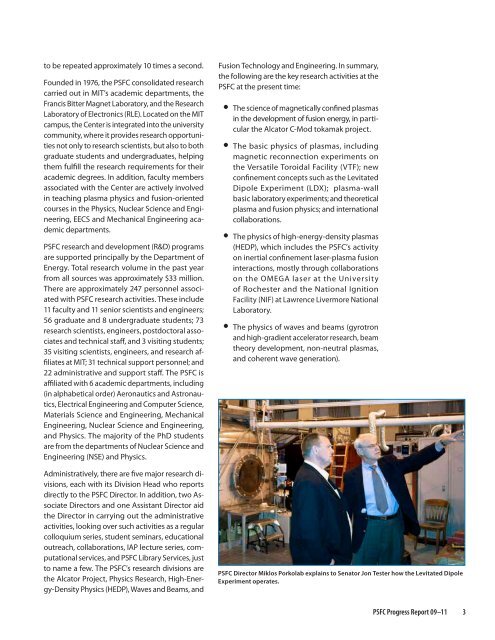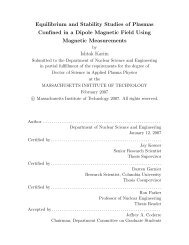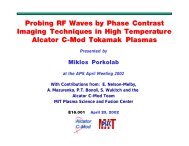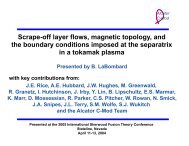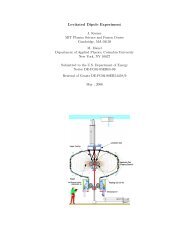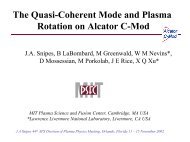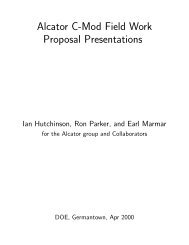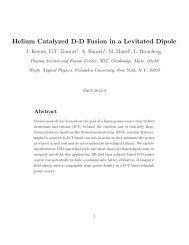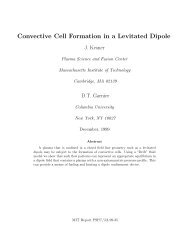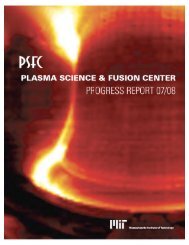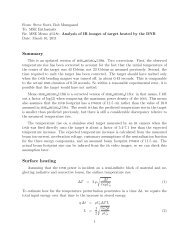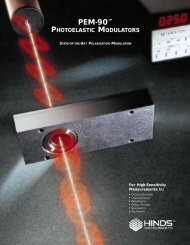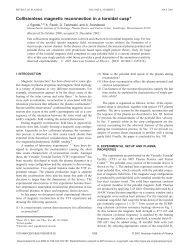Download a copy of the latest PSFC Progress Report - Plasma ...
Download a copy of the latest PSFC Progress Report - Plasma ...
Download a copy of the latest PSFC Progress Report - Plasma ...
You also want an ePaper? Increase the reach of your titles
YUMPU automatically turns print PDFs into web optimized ePapers that Google loves.
to be repeated approximately 10 times a second.<br />
Founded in 1976, <strong>the</strong> <strong>PSFC</strong> consolidated research<br />
carried out in MIT’s academic departments, <strong>the</strong><br />
Francis Bitter Magnet Laboratory, and <strong>the</strong> Research<br />
Laboratory <strong>of</strong> Electronics (RLE). Located on <strong>the</strong> MIT<br />
campus, <strong>the</strong> Center is integrated into <strong>the</strong> university<br />
community, where it provides research opportunities<br />
not only to research scientists, but also to both<br />
graduate students and undergraduates, helping<br />
<strong>the</strong>m fulfill <strong>the</strong> research requirements for <strong>the</strong>ir<br />
academic degrees. In addition, faculty members<br />
associated with <strong>the</strong> Center are actively involved<br />
in teaching plasma physics and fusion-ori ented<br />
courses in <strong>the</strong> Physics, Nuclear Science and Engineering,<br />
EECS and Mechanical Engineering academic<br />
departments.<br />
<strong>PSFC</strong> research and development (R&D) programs<br />
are supported principally by <strong>the</strong> Department <strong>of</strong><br />
Energy. Total research volume in <strong>the</strong> past year<br />
from all sources was approxi mately $33 million.<br />
There are approximately 247 personnel associated<br />
with <strong>PSFC</strong> research activities. These include<br />
11 faculty and 11 senior scientists and engineers;<br />
56 graduate and 8 undergraduate students; 73<br />
research scientists, engineers, postdoctoral associates<br />
and technical staff, and 3 visiting students;<br />
35 visiting scientists, engineers, and research affiliates<br />
at MIT; 31 technical support personnel; and<br />
22 administrative and support staff. The <strong>PSFC</strong> is<br />
affiliated with 6 academic departments, including<br />
(in alphabetical order) Aero nautics and Astronautics,<br />
Electrical Engineering and Computer Science,<br />
Materi als Science and Engineering, Mechanical<br />
Engineering, Nuclear Science and Engineering,<br />
and Physics. The majority <strong>of</strong> <strong>the</strong> PhD students<br />
are from <strong>the</strong> depart ments <strong>of</strong> Nuclear Science and<br />
Engineering (NSE) and Physics.<br />
Administratively, <strong>the</strong>re are five major research divisions,<br />
each with its Division Head who reports<br />
directly to <strong>the</strong> <strong>PSFC</strong> Director. In addition, two Associate<br />
Directors and one Assistant Director aid<br />
<strong>the</strong> Director in carrying out <strong>the</strong> administrative<br />
activities, looking over such activities as a regular<br />
colloquium series, student seminars, educational<br />
outreach, collaborations, IAP lecture series, computational<br />
services, and <strong>PSFC</strong> Library Services, just<br />
to name a few. The <strong>PSFC</strong>’s research divisions are<br />
<strong>the</strong> Alcator Project, Physics Research, High-Energy-Density<br />
Physics (HEDP), Waves and Beams, and<br />
Fusion Technology and Engineering. In summary,<br />
<strong>the</strong> following are <strong>the</strong> key research activities at <strong>the</strong><br />
<strong>PSFC</strong> at <strong>the</strong> present time:<br />
••<br />
The science <strong>of</strong> magnetically confined plasmas<br />
in <strong>the</strong> development <strong>of</strong> fusion energy, in particular<br />
<strong>the</strong> Alcator C-Mod tokamak project.<br />
••<br />
The basic physics <strong>of</strong> plasmas, including<br />
magnetic reconnection experiments on<br />
<strong>the</strong> Versatile Toroidal Facility (VTF); new<br />
confinement concepts such as <strong>the</strong> Levitated<br />
Dipole Experiment (LDX); plasma-wall<br />
basic laboratory experiments; and <strong>the</strong>oretical<br />
plasma and fusion physics; and international<br />
collaborations.<br />
••<br />
The physics <strong>of</strong> high-energy-density plasmas<br />
(HEDP), which includes <strong>the</strong> <strong>PSFC</strong>’s activity<br />
on inertial confinement laser-plasma fusion<br />
interactions, mostly through collaborations<br />
on <strong>the</strong> OMEGA laser at <strong>the</strong> University<br />
<strong>of</strong> Rochester and <strong>the</strong> National Ignition<br />
Facility (NIF) at Lawrence Livermore National<br />
Laboratory.<br />
••<br />
The physics <strong>of</strong> waves and beams (gyrotron<br />
and high-gradient accelerator research, beam<br />
<strong>the</strong>ory development, non-neutral plasmas,<br />
and coherent wave generation).<br />
<strong>PSFC</strong> Director Miklos Porkolab explains to Senator Jon Tester how <strong>the</strong> Levitated Dipole<br />
Experiment operates.<br />
<strong>PSFC</strong> <strong>Progress</strong> <strong>Report</strong> 09–11 3


